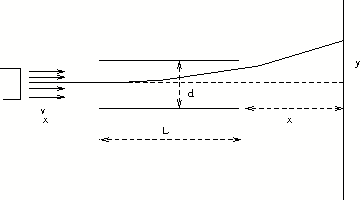[QUE/EM-01001] --- EM-PROBLEMNode id: 2886An electron moving with speed of \(5.0\times 10^8\)cm/sec is shot parallel to an electric field strength of \(1.0\times 10^3\)nt/coul arranged so as to retard its motion.
|
||
[QUE/EM-01002] --- EM-PROBLEMNode id: 2620If an ink drop has a mass of \(50\times10^{-9}\) g and is given a charge of \(-200\times 10^{-15}\) C, find vertical displacement in an inkjet printer with 3keV deflection potential, 3mm plate separation and 15 mm deflection plate length. The nozzle ejects the drop with velocity 25 m sec\(^{-1}\) and leaving edge of the deflection plate is at a distance 15 mm from the paper.Source [Kraus p117]
|
||
[QUE/EM-01002] --- EM-SolutionNode id: 5483 |
||
[QUE/EM-01003] --- EM-PROBLEMNode id: 2188
|
||
[QUE/EM-01004] --- EM-PROBLEMNode id: 2622A gold nucleus contains a positive charge equal to that of 79 protons. An \(\alpha\) particle, \(Z=2\), has kinetic energy \(K\) at points far away from the nucleus and is traveling directly towards the charge, the particle just touches the surface of the charge and is reversed in direction. relate \(K\) to the radius of the gold nucleus. Find the numerical value of kinetic energy in MeV is the radius \(R\) is given to be \(5 \times10^{-15}\) m. [ 1 MeV = \(10^6\) eV and 1 eV = \(1.6\times10^{-16}\)] |
||
[QUE/EM-01005] Problem-EM --- Small oscillations near a charged ringNode id: 2628An electron is constrained to move along the axis of a ring of charge \(q\) and radius \(a\). Show that the electron can perform small oscillations along the axis of with time period given by \[T=\frac{1}{2\pi}\frac{4\pi\varepsilon_0 m a^2}{eq}\] |
||
[QUE/EM-01006] --- EM-PROBLEMNode id: 5484 |
||
[QUE/EM-01007] --- EM-PROBLEMNode id: 5485 |
||
[QUE/EM-01008] --- EM-PROBLEMNode id: 5486Two pith balls, each of mass 1.8 g, are suspended from the same point |
||
[QUE/EM-01010] --- EM-PROBLEMNode id: 5488An alpha particle travels in a circular path of radius \(0.45\)m in a |
||
[QUE/EM-01010] EM-PROBLEM Alpha particle in magnetic field; motion in a circleNode id: 3026An alpha particle travels in a circular path of radius \(0.45\)m in a magnetic field with \(B=1.2\)w/m\(^2\). Calculate Anon |
||
[QUE/EM-01011] --- EM-PROBLEMNode id: 5489An alpha particle travels in a circular path of radius \(0.45\)m in a magnetic field with \(B=1.2\) w/m\(^2\). Calculate (i) its speed (ii) its period of revolution, and (iii) its kinetic energy. Mass of proton particle = \(1.67\times 10^{-27}\)kg \(\approx 4\times M_p= 4\times938.27\) MeV.
|
||
[QUE/EM-01012] --- EM-PROBLEMNode id: 5490Find the direction and magnitude of \(\vec{E}\) at the center of a square |
||
[QUE/EM-01013] --- EM-PROBLEMNode id: 5491A "dipole" is formed from a rod of length \(2a\) and two charges \(+q\) |
||
[QUE/EM-01014] --- EM-PROBLEMNode id: 5492Find the direction and magnitude of \(\vec{E}\) at the center of a square |
||
[QUE/EM-01016] --- EM-PROBLEMNode id: 5494An electron moving with speed of \(5.0\times 10^8\)cm/sec is shot parallel to an electric field strength of \(1.0\times 10^3\)nt/coul arranged so as to retard its motion.
|
||
[QUE/EM-02001]Node id: 5439[1] A thin glass rod is bent into a semicircle of radius \(R\). A charge \(+Q\) is |
||
[QUE/EM-02002]Node id: 5442Three equal charges are placed at the corners of an equilateral triangle. |
||
[QUE/EM-02003] Sixteen charges on a regular polygonNode id: 2625Sixteen equal charges \(q\) are placed at the corners of a regular polygon of 17 sides. Find the force exerted by these charges on a seventeenth charge \(q\) placed at the center of the polygon. |
||
[QUE/EM-02004]Node id: 5443Show that the electric field at the center of a regular \(N\)-sided polygon is <br />zero when equal charges are placed at the corners of the polygon. |
testing sample
For page specific messages
For page author info
Export as CSV
n
0
0






 ||Message]
||Message]



